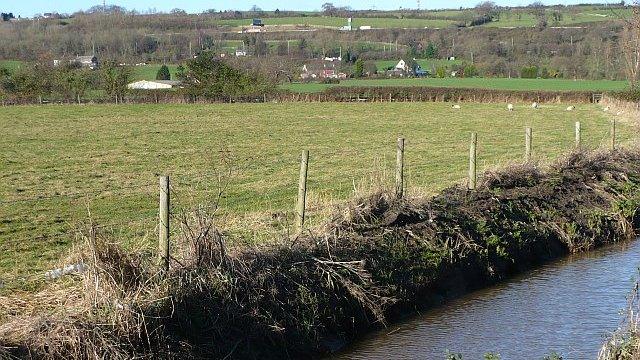Uphill challenge for cycling in Wales?
- Published
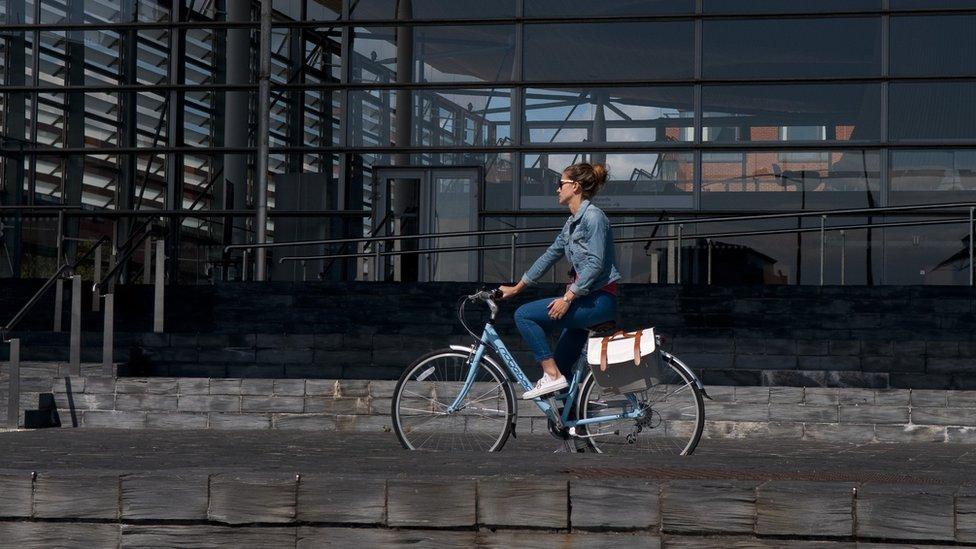
A woman rides past the Senedd in Cardiff Bay
As commuters are encouraged to take to two wheels on Cycle to Work Day, BBC News looks at the successes and challenges for cycling in Wales.
Cycling in the UK could be said to be going through a golden period in recent years.
There are no shortage of figureheads, from the Team GB cyclists' 12 medals in Rio at last month's Olympics to Chris Froome winning his historic third Tour de France in July.
But has any of this high-profile success had any impact on the levels of cycling at a grassroots level?
Figures from transport charity Sustrans Cymru, external at first glance could make depressing reading for those hoping to see a boost for the ordinary cyclist in Wales.
Statistics from 2012 - when the London Olympics also gave cycling a high-profile boost - showed journeys by bike accounted for 1% of the total volume of traffic in Wales.
Although this was an increase of 4% on the previous five years, the situation has not changed in the intervening four years - at least on paper, according to Sustrans Cymru.
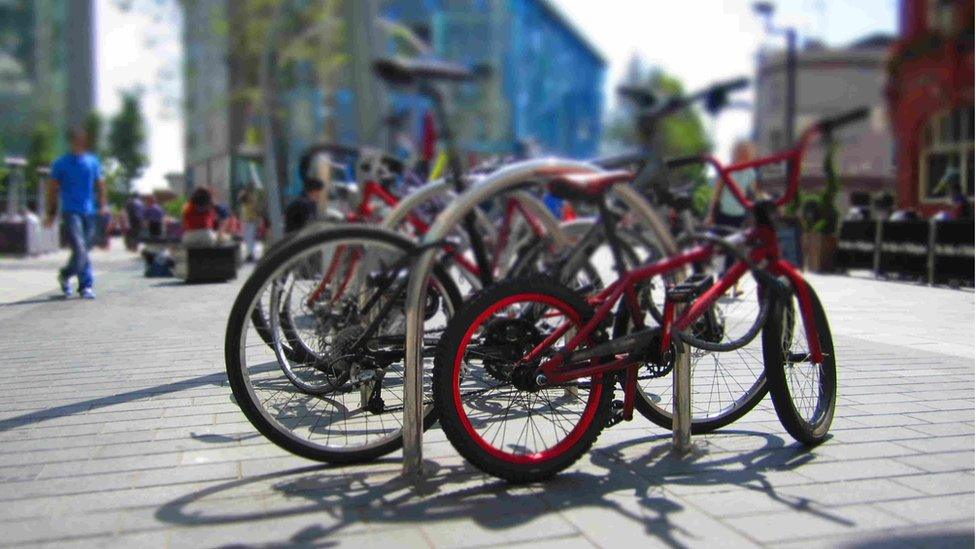
Chris Roberts, from the organisation, said one of the important things that needed to change was how figures were recorded.
He explained: "The major issue is about the ways cycling is counted, for a start. Getting accurate figures on it is quite difficult.
"People cycle in all sorts of places and people who cycle on paths aren't counted. It's a matter of surveys, and survey numbers are quite small.
"We are arguing proper monitoring is needed."
In September 2014, the Active Travel Act, external became law in Wales and local authorities have had a legal duty to plan suitable routes for active travel, and improve their walking and cycling infrastructure every year.
Last month Rebecca Evans AM, the minister with responsibility for active travel, led a launch of a campaign by walking and cycling groups to encourage the public to contribute to local authorities' plans to improve travel on foot and by bike in their locality.
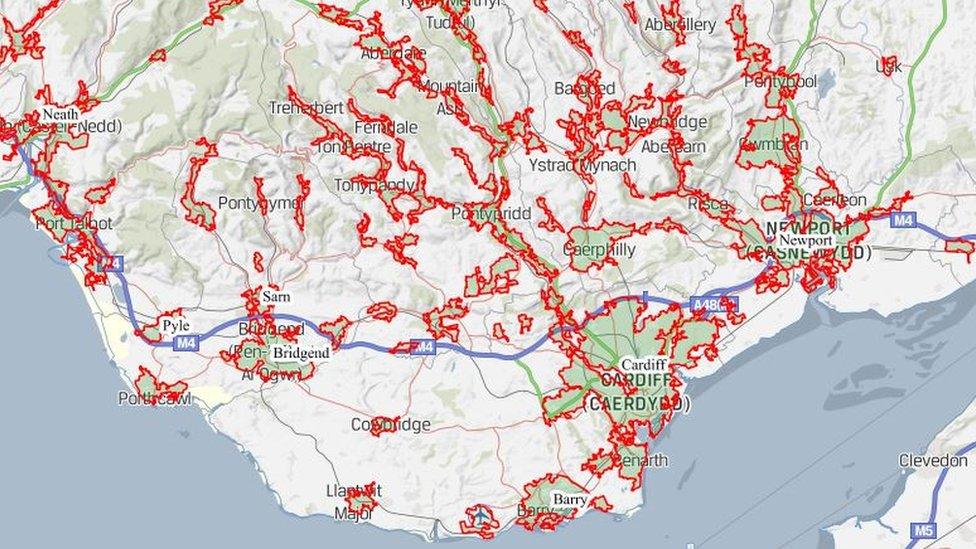
Part of the active travel map showing the designated localities the act will affect in south Wales
Mr Roberts argued there were two main strands needed to bring about a significant change in the numbers taking to their bike: the proper infrastructure and the active promotion of cycling.
"The big thing that's happening at the moment is we've now reached the stage where local authorities have to put in place their vision for the long-term future of cycling," he said.
"If they don't get this right... the whole point of the bill was there would be an integrated network travel map linking schools, shopping centres, places where people would otherwise use cars."
He said it was vital the public, as required, was involved in helping to plan the routes so they were put "in the right places" that people would actually use.
"So much of this is about having the confidence to take space off cars, having a council saying [to cyclists] 'what you're doing is an improvement and is really going to make a difference [to how people travel]'," he added.
"The specific figures for Cardiff show the number of people [cycling] is improving."

Case study: City link
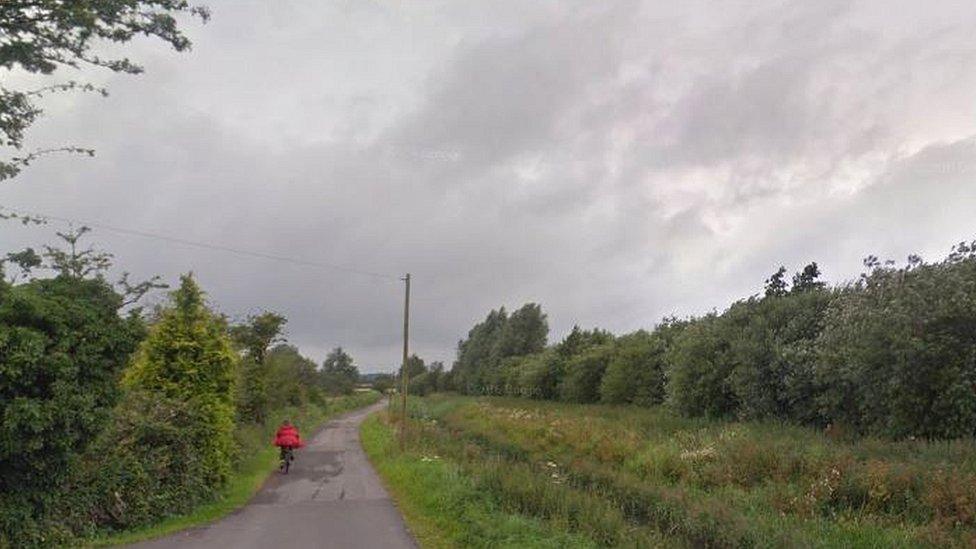
The Newport to Cardiff cycle route sometimes follows reens, or drainage ditches
In 2013, Newport and Cardiff councils announced they would be working jointly on a cycle commuting route between the two cities.
The route, using the Marshfield area, utilised some existing roads, while other "green lanes" were surfaced to provide a continuous route.
The path opened in 2015 and while there are still some improvements to be made, Newport council's transport member Ray Truman said the council had noticed a significant increase in the number of people using the route.
He added: "We will have figures once we have the results of surveys which are planned this year prior to the installation of cycle counters for which the council has had support and funding from Welsh Government."
Mr Roberts said Cardiff council had just been awarded a grant to provide cycling infrastructure in the Greenway Road area of Trowbridge, which formed part of the route.
But he added a caveat: "That will only take you to Newport Road, where there are major issues with the cycle path, and getting from Newport Road to the city centre is really problematic."

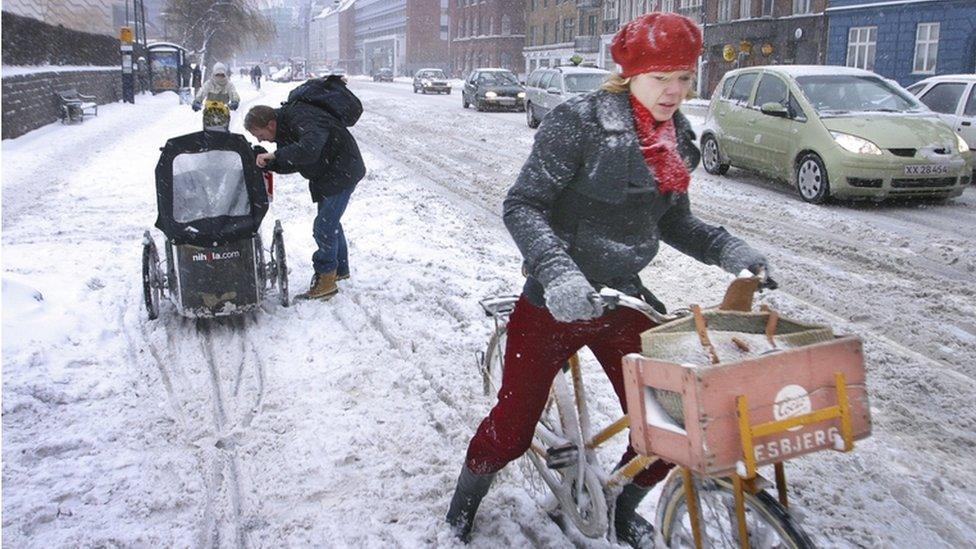
Wintry weather typically does not stop Copenhagen's cyclists from taking to two wheels
The "gold standard" in cycling uptake is the Danish capital, Copenhagen, which is hailed round the world for the impressive numbers of two-wheeled users taking to the road - through summer and snowy winter - every day.
Although Copenhagen is already - pardon the pun - streets ahead in terms of bike use, with 41% of the population cycling to work or school every day, the city has not rested on its laurels.
It is building a network of 26 bike superhighways which will be completely separate from cars and other routes. Two have already opened, one connecting the capital city to a town 14 miles (22km) away, and a third was due to open over the summer.
Is this ultimately the only way to get more people using their bikes in Wales? Topography aside - we are mountainous, Denmark is flat - safety is a very big concern for both potential and current cyclists.
Former Olympic cyclist Chris Boardman, now British Cycling's policy adviser, has joined a raft of top cyclists including Laura Trott, Mark Cavendish and Wales' Owain Doull in signing a letter to Prime Minister Theresa May calling for the UK government to tackle "chronic underfunding" in cycling, including providing networks of segregated cycle lanes.
Boardman said he was even more determined to campaign on the issue following the death of his mother Carol after a collision with a truck while cycling in Connah's Quay in north Wales in July.
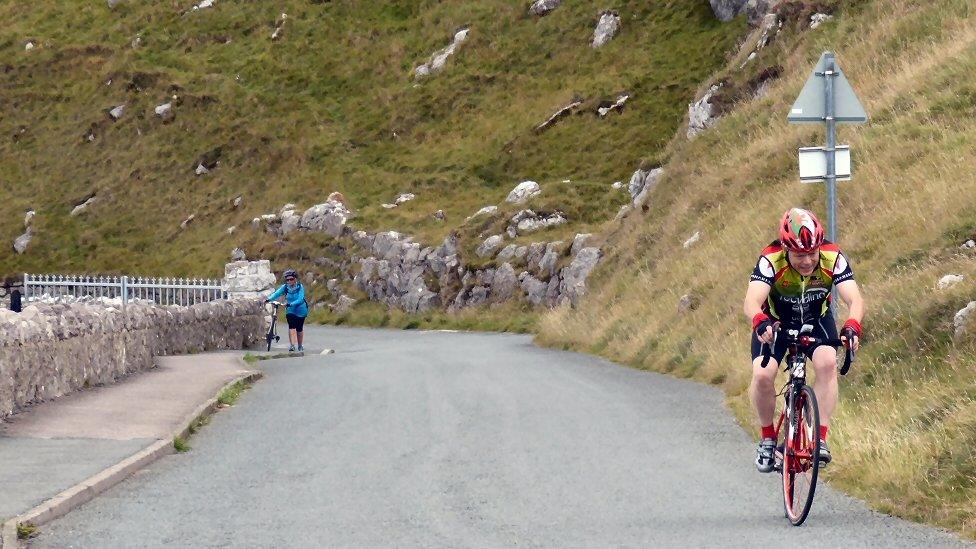
Some of Wales' slopes can be challenging, to put it mildly, as the rear cyclist in the picture shows
A survey by Bike Life Cardiff found only one in three people rated the Welsh capital as good or very good for cycling safety, with that figure dropping to one in four when the question related to children.
More than eight out of 10 wanted better safety for cyclists, and 90% of those who currently do not ride a bike but would like to said having traffic-free routes would help them to start cycling or cycle more. Tellingly, the figure was nearly as high among regular cyclists at 88%.
Mr Roberts said the solution would have to be a "mixture" of the options on offer.
He boiled it down to segregated routes being more appropriate in areas of high density road traffic.
But he pointed out: "Safe travel starts from your front door. Every street should be transformed to be safely used."
He said the use of 20mph speed limits and "changing street design so there isn't any area that cars can go through streets as fast as they want" would make a huge difference to how people perceived cycling.
So how does Cardiff measure up to the Danish city? There are encouraging signs: a 28% rise in trips by bike between 2013 and 2014; 11.5 million bike trips annually; nearly 80% of people want to see more spent on cycling.
Compared to the 41% commuting in Copenhagen, only 6% said they rode a bike every day, with the figure rising to 8% when it included people riding five to six days.
Last year, the council took a step towards altering the heavy balance in favour of motorised transport by backing plans for a car-free day every year in the city centre, following places such as Paris and Delhi, in a bid to reduce air pollution.
Great news for active travel, one would think - until it was revealed in July the planned day on 22 September would only see a single street closed. There were promises of reviews after the event, with the potential to increase the car-free area in future years.
Small steps...
- Published1 September 2016
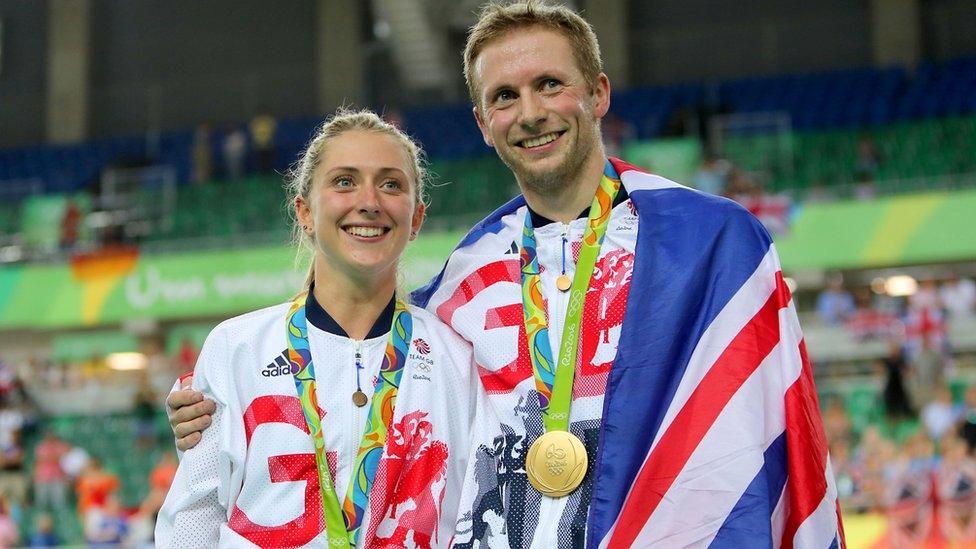
- Published12 July 2016
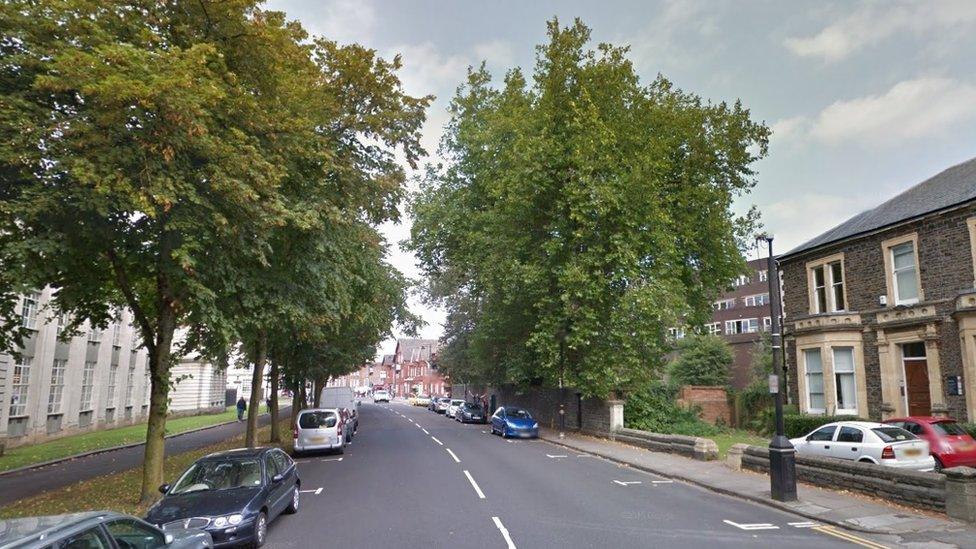
- Published15 November 2015
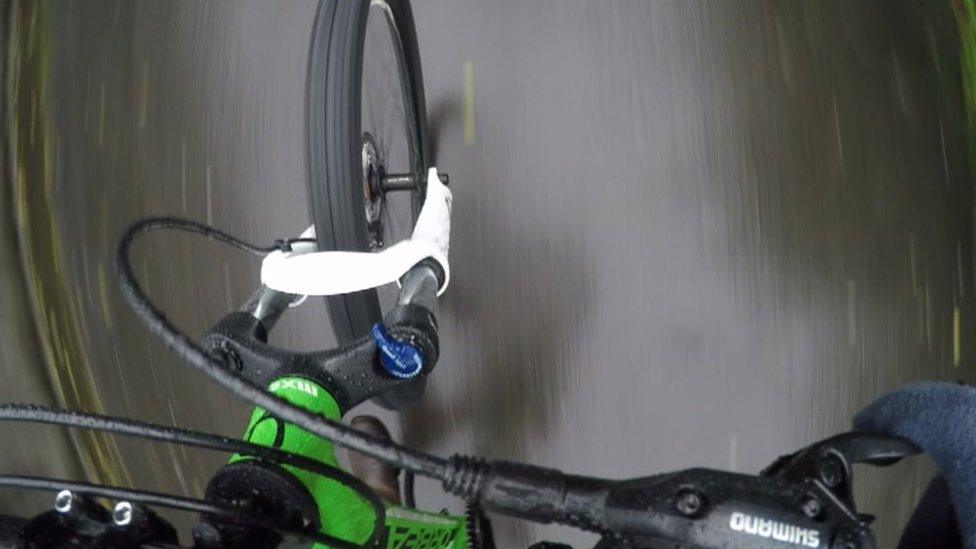
- Published26 March 2014
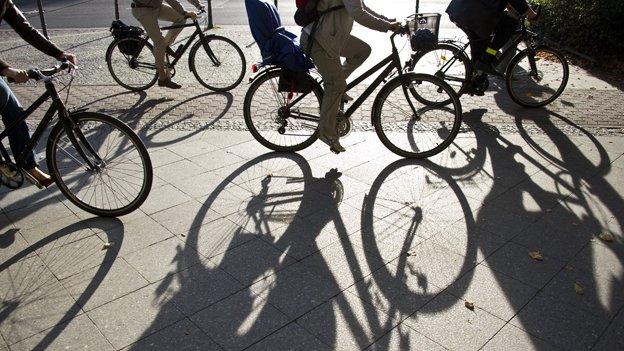
- Published16 May 2013
